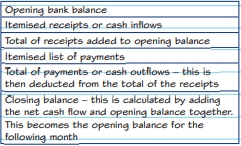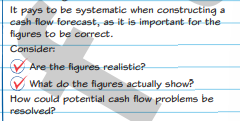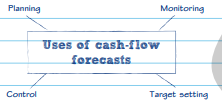Learning aim F
0.0(0)
0.0(0)
Card Sorting
1/19
Earn XP
Description and Tags
Study Analytics
Name | Mastery | Learn | Test | Matching | Spaced |
|---|
No study sessions yet.
20 Terms
1
New cards
Cash flow forecasts
Cash flow forecasts are used by businesses to identify potential problems with cash flow. This will enable them to plan, monitor and control spending more effectively.
2
New cards
format of forecast
\

3
New cards
entering data

4
New cards
Use of cash flow forecast
The flow of cash into and out of a business has to be carefully managed. Having too little cash means that suppliers, and even employees, may not be paid on time.

5
New cards
profit and cash
Businesses selling lots of products and services may have major cash flow problems. If the business is selling products and services and recording them as being sold they may be short of cash if they have sold them on credit as they will not have yet received the money. They will need to replace the inventory but as they have not been paid for items they have already sold, they may not have funds to do this.
6
New cards
Benefits and limitations
Cash flow forecasts should help the business predict when they might have cash flow problems. If the business has predicted and planned for its financial needs, then banks may extend overdrafts or offer loans. Cash flows fail to consider that a business can delay payments to increase its net cash inflows and that it can buy using a leasing arrangement to avoid using cash.
7
New cards
ways to improve cash flow

8
New cards
what does break-even analysis identify?
it identifies the point at which a business’s costs are matched by the money it receives from sales.
9
New cards
Types of costs are?
Fixed, variable and semi-variable
10
New cards
Fixed costs
These are incurred by the business regardless of how well it is doing, e.g. business rates.
11
New cards
Variable costs
These increase when the business increases its activity or output, e.g. raw materials. total variable costs = variable cost per unit × quantity
12
New cards
Semi-variable costs
These are a combination of fixed costs and costs which become variable once a certain level of activity or output is reached, e.g. fixed phone line rental plus a variable charge based on the number of calls made.
13
New cards
Total costs (TC) =
fixed costs + variable costs + semi - variable costs
14
New cards
Types of sales are?
Selling price per unit, Sales in units, Sales in value.
15
New cards
Selling price per unit
Amount paid by each customer for each item bought
16
New cards
Sales in units
Quantity of sales, i.e. number of items sold
17
New cards
Sales in value
Monetary value of sales, i.e. selling price × the number of units sold.
18
New cards
Total sales (monthly/yearly) =
number of units sold OR value of units sold
19
New cards
Total Revenue (TR) =
Total revenue (TR) = Quantity of goods sold × Selling price per unit
20
New cards
Break-even =
Total revenue (TR) = Total costs (TC)